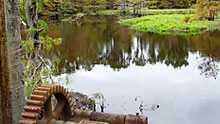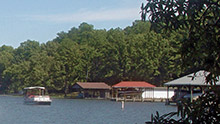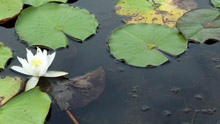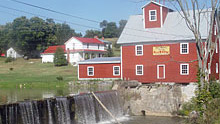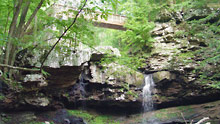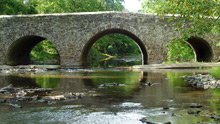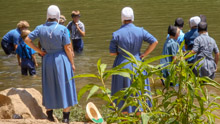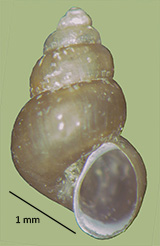> Habitat & Distribution
Thompson (1968, 1999) considered A. monas endemic to Wekiva Springs and a short length of the Wekiva River downstream in Orange County, central Florida. Counted together with all its junior synonyms, however, Aphaostracon monas ranges throughout the St. Johns River system, south through the Okeechobee system to the vicinity of Miami, and west through the lower Suwanee system into the Florida panhandle. We have seven records from our study area, primarily in springs and spring runs of the Ochlockonee and Suwannee systems. Population densities are typically greatest on mats of aquatic vegetation but snails are not uncommon on bottom sediments and debris as well. FWGNA incidence unranked.
> Ecology & Life History
Hydrobioid snails seem to be rather nonspecific grazers of small particles (Dillon 2000: 94-97). They are typically dioecious; the males being characterized by a penis that arises from the neck. Females typically attach single eggs in spare, hemispherical capsules to solid substrates.
Unlike most Floridian cochliopids, Aphaostracon populations seem to be restricted to fresh waters, as far as is known, and entirely oviparous, as one might expect. Thompson (1968) reported that the sexes are dimorphic, females larger than males and (apparently) present in greater numbers.
> Taxonomy & Systematics
The species was originally described as Paludestrina monas by Pilsbry (1899), giving the type locality as Florida s Wekiva River. Thompson (1968) transferred monas, along with eight species newly described by himself, "remarkably alike in size and general appearance," to the new genus Aphaostracon. After 25 years of residence in the large and ever-expanding Hydrobiidae (Kabat & Hershler 1993) Aphaostracon was segregated into the family Cochliopidae by Wilke and colleagues in 2013.
The penis of Aphaostracon is typically cochliopine. Thompson (1968, 1999) subdivided his nine species into three groups: pycnus, theiocrenetus and asthenes lacking penial papillae, rhadinus, hypohyalina, and monas with one or two papillae, and pachynotus, xynoelictus and chalarogyrus with three papillae or more. He admitted that the number of papillae was not consistent, however. Within groups, Thompson differentiated species by minor characters of shell and operculum.
Our research with populations of the western hydrobioid Pyrgulopsis (Liu & Dillon 2021) has returned no evidence of reproductive isolation correlated with variation in penial lobes, papillae, or glandular regions, nor any support for the hypothesis that any such minor detail of penial morphology might suggest specific significance. (See our essay of 7Sept21from the link below for more.) Thus, we consider all eight Aphaostracon species described by Thompson in 1968 (rhadinus, hypohyalina, pycnus, theiocrenetus, asthenes, pachynotus, xynoelictus, and chalarogyrus) simple junior synonyms of monas (Pilsbry 1899).
See Hershler & Thompson (1992) for a broad-brush review of Aphaostracon within the larger context of the Cochliopidae. Hershler et al. (1999) included two Aphaostracon individuals among the outgroups they sequenced for their CO1 gene tree analysis of the western cochliopid Tryonia. That same pair of sequences was also included in the larger CO1 molecular phylogeny of the Cochliopidae published by Liu et al. (2001).
> Maps and Supplementary Resources
> Essays
- Earlier versions of this website, online until August of 2016, adopted the large, broadly-inclusive concept of the Hydrobiidae (sl) following Kabat & Hershler (1993). More recently the FWGNA project has shifted to the Wilke et al. (2013) classification system, distinguishing a much smaller Hydrobiidae (ss) and elevating many hydrobioid taxa previously ranked as subfamilies to the full family level. For more details, see The Classification of the Hydrobioids.
- See my essay of 7Sept21, Just 125 species of Pyrgulopsis in the American West, for a review of the paper by Liu and Dillon (2021) demonstrating striking variation in both shell and penial morphology within a single population of Pyrgulopsis gibba.
> References
Dillon, R. T., Jr. (2000) The Ecology of Freshwater Molluscs. Cambridge, Cambridge University Press. 509 pp.
Hershler, R. & F. G. Thompson (1992) A review of the aquatic gastropod subfamily Cochliopinae (Prosobranchia: Hydrobiidae). Malacological Review Supplement 5: 1 - 140.
Kabat, A.R., and R. Hershler (1993) The prosobranch snail family Hydrobiidae (Gastropoda: Rissooidea): review of classification and supraspecific taxa. Smithsonian Contributions to Zoology 547:1-94.
Liu, H-P, and R. T. Dillon, Jr. (2021) Resolving the species status of Surprise Valley Pyrg (Pyrgulopsis gibba) and Vineyard Pyrg (Pyrgulopsis vinyardi). Report to Stantec Environmental Consulting. FWGNA Circular 6: 1 5. [pdf]
Liu, H-P., R. Hershler, & F. G. Thompson (2001) Phylogenetic relationships of the Cochliopinae (Rissooidea: Hydrobiidae): An enigmatic group of aquatic gastropods. Molec. Phylog. Evol. 21: 17 - 25.
Pilsbry, H. A. (1899) New Amnicolidae from Florida. Nautilus 13: 20 22.
Thompson, F. G. (1968) The Aquatic Snails of the Family Hydrobiidae of Peninsular Florida. Gainesville: University of Florida Press. 268 pps.
Thompson, F.G. (1999) An identification manual for the freshwater snails of Florida. Walkerana 10: 1 96.
Wilke, T., G.M. Davis, A. Falniowski, F. Giusti, M. Bodon, and M. Szarowska (2001) Molecular systematics of Hydrobiidae (Mollusca: Gastropoda: Rissooidea): testing monophyly and phylogenetic relationships. Proceedings of the Academy of Natural Sciences of Philadelphia 151: 1 21.
Wilke T., Haase M., Hershler R., Liu H-P., Misof B., Ponder W. (2013) Pushing short DNA fragments to the limit: Phylogenetic relationships of hydrobioid gastropods (Caenogastropoda: Rissooidea). Molecular Phylogenetics and Evolution 66: 715 736.

